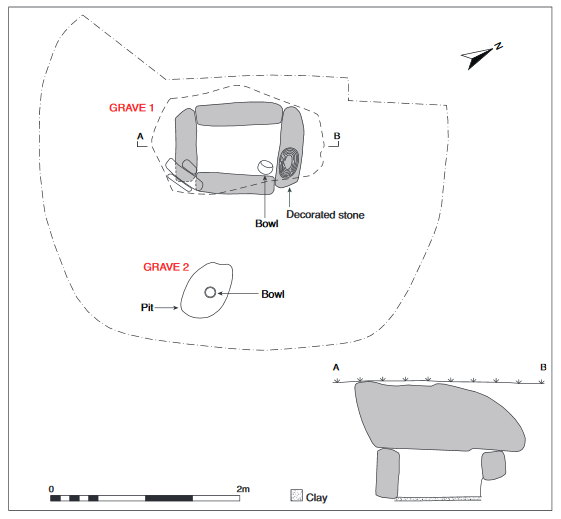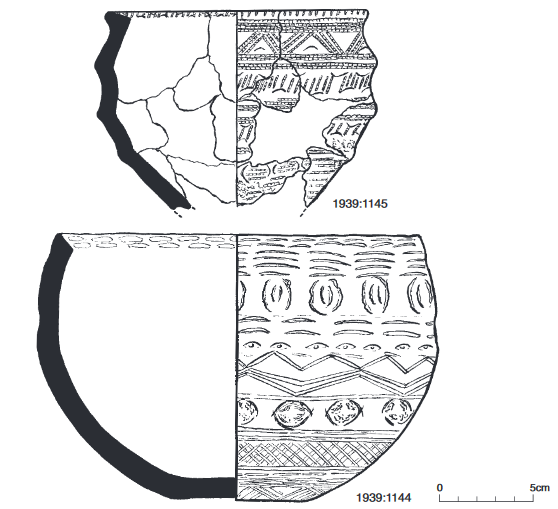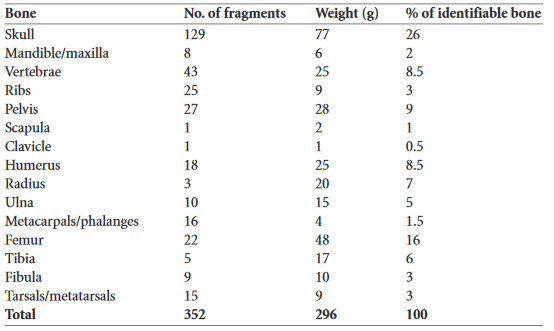County: Dublin Site name: COURTLOUGH, CO. DUBLIN
Sites and Monuments Record No.: SMR DU005-041 Licence number: E1059
Author: HOWARD KILBRIDE-JONES AND WILLIAM MONKS
Site type: Early Bronze Age graves
Period/Dating: —
ITM: E 719203m, N 758854m
Latitude, Longitude (decimal degrees): 53.566039, -6.200456
Introduction
In April 1939 a short cist containing a bowl was discovered during ploughing on ‘Moat Hill’, near Balbriggan, north Co. Dublin. The exact circumstances of the discovery are not known, but the find was reported to the NMI by the Gardaí at Balbriggan. The cist was investigated over a three-week period, first by Mr Henry Morris and then by Mr Howard Kilbride-Jones and Mr William Monks. During his investigation, Mr Morris took possession of the bowl on behalf of the NMI. Mr Kilbride-Jones later visited the site and excavated and planned it. This excavation revealed a pit burial just east of the cist, containing a cremation and a fragmentary bowl. Mr Monks and fourteen assistants completed the excavation and dismantled the cist,and also discovered two smaller patches of cremated bone west and east of the cist respectively. Photographs are also on file from Dr L.B. Somerville-Large, who apparently visited the site at the time of excavation. As there is no excavation report on file, this report is based on the correspondence, photographs and drawings in the file. The human remains were analysed by Laureen Buckley.

Location(Fig. 3.55)
The site was in the townland of Courtlough, north-east Co. Dublin, close to the border with County Meath.76 It lay on farmland, on a hill known locally as Moat Hill, at an altitude of between c. 90m and 120m above sea level. The term ‘Moat Hill’ may indicate the former presence of a mound or tumulus, since destroyed. No other sites of similar type or date are known from this townland.
Description of site
Grave 1
The cist was rectangular in plan, with its long axis aligned north-north-east/south-south-west. Internally it measured 0.89m long by 0.55m wide by 0.53m high (Fig. 3.56).77 It was formed of four main slabs set on edge, with one making up each wall of the cist. The slabs were relatively regular in form, except for the northern end slab, which was much lower in height (0.29m as opposed to the southern end slab, which was 0.53m high). This northern end slab was exceptional in that it bore decoration in the form of a ‘picked-out basin’ on its upright end and incised parallel lines on its side.78 The maximum length of the side slabs was 0.92m and that of the end slabs 0.84m. The height of the side and end slabs was supplemented at the south-

western corner by smaller stones laid on top of the main slabs so that the capstone would rest level on them. There were no packing stones indicated around the cist on the plan. The capstone was megalithic in appearance and lay only a few centimetres below ground level (Pl. 24). It was irregular in shape, measuring 1.81m long by 1.1m wide by 0.72m thick, and its size led the excavators to comment that the cist looked more like a ‘dolmen’ sunk into the ground than a cist burial. The floor of the cist was formed of clay and the pit dug to receive the cist is not shown on the plan. There was no evidence for bone in the cist, but a simple bowl had been placed in the north-east corner.79 It was complete when found and appears to have been lying on its side in the cist, just below the decoration on the northern end stone.
Simple bowl, 1939:1144(Fig. 3.57)
The rim is bevelled internally and decorated with short, thick, plain impressions. Externally the ware is reddish in parts and the decoration as a whole is poorly executed. There is a slight suggestion of a shoulder and a slight constriction. On the upper neck the decoration consists of six short rows of interrupted horizontal lines, and below this zone another bearing roughly opposing semicircle impressions. In the shoulder ‘groove’ are thick plain impressions, and just below the shoulder is a badly executed horizontal line of impressed chevron. This decoration is repeated lower down with additional bands of lattice and triangular patterns. The base is plain.
Dimensions: max. H 15.2cm (vessel is lopsided); ext. D rim 20cm; D base 7cm.

Grave 2
This pit was discovered during the excavation of the cist. It lay approximately 0.7m south-east of the eastern side stone of the cist (Fig. 3.56). The pit was roughly oval in plan, with its long axis aligned north-west/south-east. It measured 0.67m long by 0.43m wide.80 There was no evidence for structural stones. The pit contained the cremated remains of one adult and one adolescent (1939:1148), and sherds of a ribbed bowl.
Ribbed bowl, 1939:1145(Fig. 3.57)
The vessel is a three-ribbed bowl as classified by Ó Ríordáin and Waddell (1993, 216). It survives in very incomplete condition. It is decorated with comb impressions forming triangular and vertical bands, with horizontal lines separating the bands.
Dimensions: est. D 15cm.
Grave 3 (possible)
According to William Monks, this was found 1.8m (6ft) east of the corner of the cist and consisted of an unprotected deposit of cremated bone. It occurred at a depth of 0.46m above the tops of the side stones of the cist.81 The following description is given: ‘the soil in which the bones rested seemed different from the surrounding soil. It was darker’. The dimensions of this deposit are not provided. The human remains were not retained.
Grave 4 (possible)
This was located 1.5–2m west of the cist and again consisted of a patch of bone. No further details are recorded. The deposit consisted of a ‘small quantity of bones’ (it is not stated whether these were burnt or unburnt). These remains do not seem to have been acquired by the NMI.
Comment
The human remains from this site have not been dated. The cist, pit and two other small deposits of bone are indicators of a small cemetery. There is nothing recorded to suggest that a cairn or mound had been disturbed, although, given that the area was known as ‘Moat Hill’, it may be that a low mound was ploughed out and that continuous ploughing eventually exposed the cist.
The simple bowl discovered in the cist is quite large by comparison with other vessels of the type. The decorative scheme with its open, widely spaced ornament fits best with stage 3 (Brindley 2007, 174–7) in the development of the bowl series, which is dated to 1980–1930/20 BC. The ribbed bowl also fits best with the stage 3 typology as described by Brindley.
HUMAN REMAINS
LAUREEN BUCKLEY
Description of sample
There was no registration number on the cremation provided for analysis, but since only one cremation was recorded as having been brought back to the Museum, presumably this is the sample from grave 2, NMI 1939: 1148. The sample consisted of 1,879 fragments of cremated bone, weighing a total of 646g. The bone was white in colour and was efficiently cremated, with a chalky texture. There were several horizontal fissures on the bone surface. One fragment of skull was a slight blue colour and some bones were spotted with a brown colour. Obviously the sample is much smaller than the 1,600–3,000g expected from a full adult cremation. There may have been some disturbance on the site prior to the collection of the bone, or it may be that only relatively large fragments were collected. Without this information it is not possible to say whether or not the full cremation was collected from the funeral pyre.
Table 3.26—Fragmentation of bone, 1939:1148.

The fragmentation of the sample is presented in Table 3.26. It can be seen that, although there is only a small proportion of very large fragments, the medium-sized fragments more than 10mm in length make up over 90% of the sample. The high proportion of medium-sized fragments is probably due to the fact that there were no covering stones on the cist and the bone had been broken up by the weight of soil on top of it. It is likely that there was a high proportion of large fragments originally.
Identifiable bone
As the fragments were not very large but moderate in size, the amount of bone that could be identified is smaller than expected in a Bronze Age cremation. A total of 296g (46% of the total bone) were identified (Table 3.27).
Table 3.27—Proportion of identified bone, 1939:1148.

Table 3.28—Summary of identified bone, 1939:1148.

Table 3.28 summarises the main parts of the skeleton identified from this sample. It can be seen that the proportion of skull is higher than expected and the proportion of lower limb is lower than expected. As the cremation was not complete, however, it cannot be expected that the skeletal elements would be in the right proportions.
Description of identifiable features of the bones
Skull
Most of the fragments were fragments of calvarium with parietal and frontal bone present. Also present was the mastoid area of a temporal bone. There was one fragment of an orbit. The sutures of the skull appeared to be open. Some of the fragments had blue flecks on the outer surface.
Mandible and maxilla
There was one fragment of mandibular condyle and a fragment of the body with the genial tubercle present. Part of the right ramus from near the internal angle with a partial socket for a molar was also present, and there was a fragment of internal surface of the body with a few sockets visible. There were a few small fragments of maxilla but only one partial tooth socket was present.
Dentition
The few incomplete tooth sockets that were present could not be identified. There were ten tooth fragments, including one upper molar with roots complete and crown shattered, two possible upper premolars and other fragments of unidentifiable roots.
Vertebrae
The bodies of three lower cervical vertebrae were present, as well as some articular surfaces from the neural arches. There were several disarticulated articular surfaces from thoracic vertebrae as well as one almost complete thoracic body and fragments of two other bodies.
Three fragments of lumbar bodies and some articular surfaces were also present.
Ribs
Mostly small fragments of shaft, but three fragments of the transverse articular surfaces and one head were also present.
Pelvis
Several fragments of ilium and fragments of ischium, including fragments of acetabulum.
Scapula
A fragment of an almost complete glenoid fossa was present.
Clavicles
A fragment from near the medial end with unfused epiphysis.
Humerus
This consisted mainly of fragments of shaft, including the proximal and distal shaft and fragments of two distal joint surfaces.
Radius
Fragments from the shaft were present.
Ulna
Fragments from the distal shaft were present, as well as fragments from the proximal end near olecranon.
Metacarpals and phalanges
Some metacarpal shaft was present, as well as a few fragments of carpal bones. There were also at least four proximal, two middle and three distal hand phalanges, with one of the middle phalanges and one distal phalanx being complete.
Femur
Most of the fragments were from an adult shaft, some with the linea aspera visible. However, there were two fragments of adolescent/juvenile femur from the left and right bones with the lesser trochanters visible.
Tibia
All the fragments were shaft fragments.
Fibula
Fragments of shaft were present, some from the distal shaft and some from the proximal shaft, and there was also one fragment of distal joint surface.
Tarsals/metatarsals
At least one navicular, one cuneiform and a cuboid were present, along with the head of a first metatarsal and the head of one other metatarsal and a few fragments of shafts.
Minimum number of individuals
There appeared to be at least two individuals present, one adult and one adolescent.
Summary and conclusions
The sample consisted of 646g of efficiently cremated, medium-sized fragments of bone. The fragmentation may have occurred because of soil pressure since the cist was uncovered. Although the weight of bone recovered does not represent a full adult cremation, most skeletal elements were identified. The partial remains of at least two individuals were identified; one was an adult of unknown sex and the other was an adolescent.
76. Parish of Balrothery, barony of Balrothery East. SMR DU005-041——. IGR 319278 258834.
77. These measurements differ from those given by Waddell. Waddell’s figure seems to be taken from the Register sheet in the NMI file, which gives the measurements as ‘approximately 3ft x 1.5ft’. In this volume, the measurements are taken from Kilbride-Jones’s plan.
78. 1939:1147. The incised lines may be natural. The stone was apparently acquired but has not been located since 1968.
79. A quantity of clay found within the vessel was also retained (1939:1146).
80. Its depth was not recorded.
81. This was presumably upslope of the cist, as the cist was only a few centimetres below ground level (Fig. 3.56)